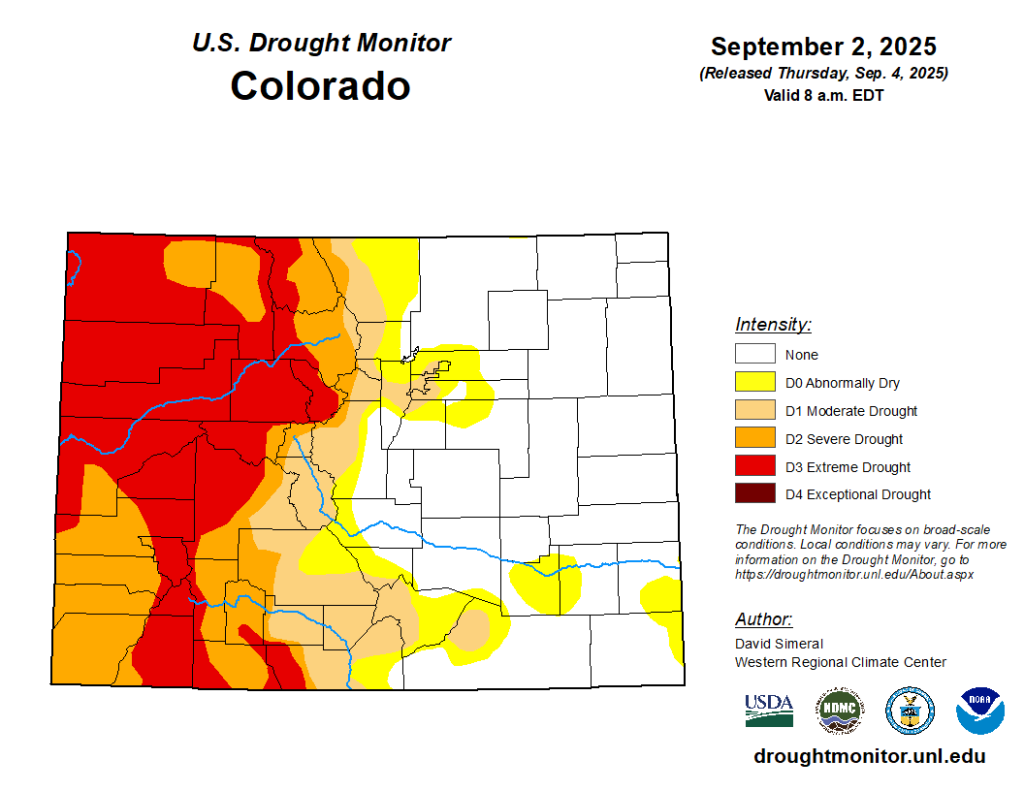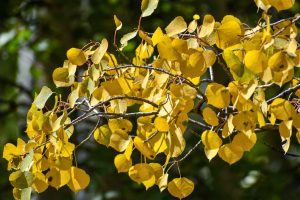A dry summer’s effect on autumn
What western Colorado’s 2025 drought means for fall colors in Garfield County

Jaymin Kanzer/Post Independent
April showers may bring May flowers, but August sun doesn’t always equate to September fun.
According to the U.S. Drought Monitor, over 99% of the Garfield County population has been experiencing “extreme drought” since Aug. 5. The last time less than 90% of the county experienced less than “abnormally dry” conditions was early January.
The drought — with no current end in sight — can have dreadful consequences on Garfield County’s local economy, energy, and serene ecosystem, according to Grand Junction National Weather Service Meteorologist Lucas Boyer. Both the aesthetic and health of the unique valleys in Garfield County are at risk because of the exceptional lack of precipitation and intense heat.

The warm fall colors typical of the Western Slope will be under closer watch in 2025 after prolonged precipitation stress on local vegetation.
Adam McCurdy, the Forest and Climate Director at the Aspen Center for Environmental Studies, said that the severe drought could push the peak fall foliage up a week — perhaps even muting some of the colors in the process, though said it wouldn’t be “abnormally poor.”
“No,” McCurdy said. “It might push things up a little bit earlier, and we may see some areas — particularly southern-facing drier hillsides — having some trees get this burnt-brown look on their leaves, as their leaves are actually dying rather than senescing gracefully, but we will still get a pretty good show.”
The process of leaves changing is known as senescence, a vital process for a tree’s ability to push through winter and capability to retain vitamins through spring. Much like animals collecting food for hibernation, trees pull the nutrients from the leaves, resulting in the aesthetically pleasing burnt yellow, orange, and red colors that are synonymous with autumn.
This natural cycle is vital for the foliage’s health, though the vegetation is struggling to make it to the point of being able to senescence the way they need to.
“It’s known as hydraulic failure,” McCurdy explained. “It’s basically the tree or plant is trying really hard to get water, and it will keep trying to pump even if there is no water. Eventually the xylem that the tree is trying to pull water from will start to collapse. When that happens, rather than seeing leaves go through their normal process of senescence, we start to see leaves dying instead. That’s when you’ll see leaves growing from green to crispy dark brown leaves that don’t necessarily fall right away.”
The effects of the drought, and overall lack of water, can be spotted throughout the valleys. The Colorado and Roaring Fork rivers, tributed by the Crystal, and Frying Pan rivers, are flowing far below the median and aren’t able to keep up with last year’s subpar flows.
The Roaring Fork River was flowing at 409 Cubic Feet per Second (CFS) on Tuesday morning, according to the United States Geological Survey. Gauged in Glenwood Springs, the river was flowing 300 feet below the 703 CFS Sept. 9 median — measured through 117 years of data.
The Colorado River, obligated to supply over 40 million people with water, is feeling similar stress on its high-alpine supply. The Colorado was flowing at 1860 CFS on Tuesday morning, gauged outside the Rifle Airport. According to the USGS, the river is flowing far below the 2285 CFS median, though is not considered “low,” as the flow has not dipped below 1290 CFS — measured with 58 years of data.
A massive contributor to the low flows has been the noticeable lack of precipitation throughout the Western Slope, and Boyer, will be one of the strongest hands holding Garfield County in drought conditions as fall begins.

“We’ve had some rainfall recently, but it’s been very localized thunderstorms and showers,” Boyer said. “When it comes to these extreme drought numbers, isolated showers that drop half an inch unfortunately don’t move the needle too much. What’s needed is really widespread soaking rain that can help refresh the vegetation.
“There are some little glimmers of hope,” he added. “There is going to be a bit of an uptick in moisture throughout September as we get into our fall pattern. There is a storm coming through this week on Wednesday, Thursday and Friday, that will hopefully cool things down a little bit. Daylight hours are shrinking too which should help, but we really need the widespread soaking rain to move the needle.”
McCurdy agreed with Boyer’s call for moisture, and expanded upon his point — explaining that 2025 shouldn’t be looked at in a vacuum, rather the context of the past 25 years need to be considered as well.
“Since 2000, we’ve been in a state of drought over twice as often as we’ve been in a state of above average moisture,” McCurdy said. “For plants, and especially trees, those effects are cumulative, and every year that they’re under stress and every year they experience premature senescence or hydraulic failure is another nail in the proverbial coffin. It’s a cumulative stress, and these bigger drought years can push either individual organisms like a single tree, or clonal organisms, like an aspen, over the edge to where they’re no longer able to survive.”

Support Local Journalism

Support Local Journalism
Readers around Glenwood Springs and Garfield County make the Post Independent’s work possible. Your financial contribution supports our efforts to deliver quality, locally relevant journalism.
Now more than ever, your support is critical to help us keep our community informed about the evolving coronavirus pandemic and the impact it is having locally. Every contribution, however large or small, will make a difference.
Each donation will be used exclusively for the development and creation of increased news coverage.









